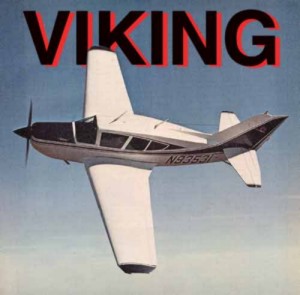
Watching
the angular arrow of wood and fabric taxi
onto the ramp, I couldn't help but marvel at
the history behind the Bellanca Viking,
whose basic design is actually far older
than I am. The plush EI Dorado interior and
space-age avionics may be a far cry from the
early pin-ball styling of the original 1937
Bellanca Junior, but the basic bones and
lines show that the Viking 300A and the
Junior are much more closely related than
many other aerial father-and-son acts now
being produced. The Viking graphically shows
just how far the industry has, or hasn't,
come in the past 37 years. It was far ahead
of its time when born, and is still
considered by many to be the Ferrari of the
four-place light airplane field, but in some
ways it's still an anachronism.
What an absolute headwrecker the original 14
series Bellanca Junior must have been when
it popped into the 1937 aviation scene.
Lean, trim, and so fast for its power as to
be sinful, it flitted around like a mosquito
among the Staggerwings and Reliants then in
vogue. Its happy little 90-hp Ken-Royce, or
LeBlond, radial could drag it along at over
120 mph and what a song that tiny round
engine must have sung.
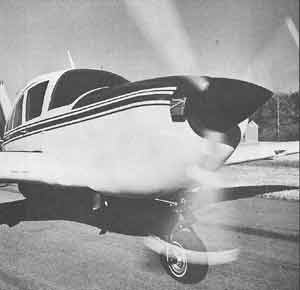
The Viking can be had with 300 hp in the
nose from either Lycoming or Continental
After the war,
the cramped three-place fuselage of the
Junior and its radial engine gave way to an
equally cramped four-place cabin and a
motley procession of flat engines (120-,
150- and 165-horse Franklins; 190- and
230-hp Lycomings), but the lines and size
remained almost exactly the same. As I
looked over the 1974 Weld-wood wonder that I
was to explore for the weekend, I had to
remind myself that the vital statistics of
the Bellancas haven't changed a fraction of
an inch since the very first junior: 34 feet
of span and 161 square feet of wing to hold
it up. However, two other important numbers
have changed mightily over the years: The
cowling now stables 300 giant horses rather
than a very wobbly 90, and the Viking weighs
in 500 pounds heavier when empty (2,250
pounds) than the Junior did at gross (1,700
pounds). Unfortunately, modern performance
figures reflect the added weight more than
the higher horse-power.
The Viking has always been the darling of
the typewriter prophets, so it gets its
share of press coverage. Aviation writers
love to borrow a Viking and go romping off
to San Juan, Barbados or Peoria because the
airplane has so much class. Because of this,
you'd have to be a hermit not to know the
familiar "built by Old World craftsmen a
piece at a time" story. It's a theme that
would wear thin if it weren't so true.
Bellanca is the last builder of four-place
people haulers to hold out against
cookie-cutter assembly line methods. The
wood wings are the result of a 60-year love
affair with spruce, and really are built by
master elves a piece at a time. Modern glues
and sealers have made a good thing even
better. The factory is fond of pointing out
that there has never been a failure or an
airworthiness directive against a Bellanca
wing, regardless of age, and the stuff they
dip the finished wings in pushes any
possibility of rot far off. (Editorís
Note from 2003: They canít say that about
Bellanca wings any more. Only a couple years
after this was written, several lost wings
prompting a major flurry of ADís).
The jungle gym of chrome-moly tubing begins
at the motor mount and ends at the rudder
post, giving the passengers one of the best
crash-survivability structures flying. It's
not light, and it's not easy to build, but
it makes one hell of a crash cage. The
fuselage sets aircraft structures back 40
years, back to the days when you could hit
the ground pretty hard and not worry about
the airplane collapsing and wrapping itself
around you.
Both the wings and the fuselage get a
finishing cover of dacron and dopeóa
surprising change from the fibreglass cloth
they used during the '60s. Although the
Dacron's life will average only about 10
years (a number that varies drastically
depending on storage, use and care).
As any engineer will tell you, there's a lot
to be said for wooden wings; they have an
infinite fatigue life (almost), and they can
be made incredibly smooth. But they cost
more than the same animal in metal and not
only is quality spruce getting tough to
find, but finding men who are artists with
chisels is no easy task either.
The airplane I managed to con the factory
into giving me was a shiny, new 1974 job
with enough options and avionics to raise
the $34,400 base price up to a sizzling
$50,000 plus (From the 2003: that sounds
pretty silly now, doesnít it?).
I think I should mention from the very
beginning that I'm what's known as your
basic Bellanca buff. I've been flipped out
over them since the first time I wiggled
into a 230hp triple-tailed job years ago.
They've always been a hundred yards the
other side of ugly, and the Bellanca
engineers who designed the original
cardboard constellations must have thought
leg-room an unnecessary option. But they
were the best flying airplanes around.
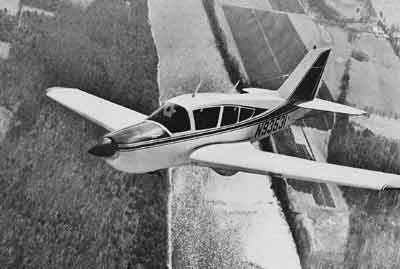
Preflighting
the airplane revealed a curious combination
of intelligent innovation and questionable
planning. The cowl, for instance is a
well-made two-piece affair with two rather
smallish doors for access to the dip-stick
and oil filler cap. To inspect the engine
you either have to remove a bunch of screws
and split the cowl or be satisfied with
peeking through various holes. They were
thoughtful enough to mount a remote
gascolator drain right next to the dip stick
so you don't have to suffer through the
usual gas-down-the-elbow routine while
fumbling under the nose for the quick drain.
I like that little bit of added convenience.
The wing drains, on the other hand, are
almost totally invisible, being mounted
inside the bottom of the wing and reached
through a small, nail-sized hole. To drain
them you must use a special cup supplied by
Bellanca that has a plunger sticking up out
of it, which you insert in the wing hole and
push. It's an extremely clever and
aerodynamically clean way to handle the tank
drains, but it takes a lot of scrounging
around and knee-dirtying to get at them.
Even the Bellanca sales type who was
checking me out had trouble locating the
drains. There has to be a better way.
Throughout its long career, Bellanca has
always had a reputation for building
spectacular performing airplanes with rather
unspectacular, dowdy interiors and panels,
but the Viking has changed that image once
and for all. As I popped the door open and
slid across into the left seat, I was
knocked out by the plushness that leaped up
and sucked me inside. Boarding may not lend
itself to displaying your more graceful
movements, but the contortions have their
rewards because the entire cabin reeks of
class and incredible detail. Only the tiny
remnants of a piece of masking tape on a
window frame kept the cabin from being a
hundred-point concours winner, but
ninety-nine sure ain't bad. Absolutely
nothing else being produced touches it.
This particular demonstrator was done in a
zowie blue naugahyde and fabric that was
brilliant, but at the same time very
tasteful. The only gripe heard from those
who romped through this aerial playroom with
me was about the headliner material. It's a
blue version of the usually mouse-coloured
mohair that '48 Hudsons and others used so
ineffectively. It looked like it would dirty
very quickly and the texture didn't come up
the modern levels set by the rest of the
interior. A vinyl headliner is available as
an option and would sure be worth the extra
bucks.
The panel is exactly what an airplane
instrument panel should be. There are no
cutesy design gimmicks aimed at hiding the
fact that you're in an airplane, like the
all-too-familiar plastic and fake wood
automotive syndrome. Rather, it's black and
businesslike with most of the goodies right
where they should be. A number of the engine
instruments (manifold pressure and
tachometer included) are the vertical kind
with floating needle indicators. They were
almost impossible to read at first, but
inside of an hour or so they became as
familiar as the old-fashioned clock gauges.
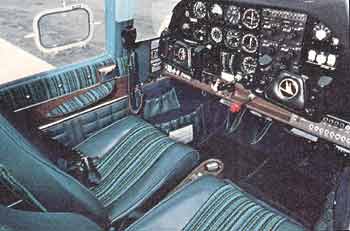
It's easy to
see why Bellanca is using so many vertical
gauges-they need the room. The limited
cockpit depth means the panel must jut
upward a fair amount to give enough space to
mount the array of gadgets most modern
pilots think they need. But, even with a
sizeable hump in the panel, they've had to
squeeze switches and knobs into just about
every corner of the panel and onto consoles
on both sides of the cockpit.
The only thing about the entire airplane
that struck me as being just plain stupid
was the location of the fire extinguisher.
It's on the floor behind the pilot's seat,
precisely where he can't reach it and the
passenger can't avoid it. That doesn't show
much planning. However, balancing off the
fire extinguisher faux pas is the placement
of the fuel selector and tank gauges. The
selector is between the seats and is one of
the easiest to work and best located ones
I've ever seen. The selector is coupled with
a system of lights under the fuel gauges.
The selector lights the bulb below the
indicator of the tank that's in use, so
there's no guessing about whether or not
you're working on the fullest tank.
As I strapped in, I mentally gave Bellanca a
gold star for mounting shoulder harnesses
(cross-over chest belts that snap into the
top of the seatbelt buckles) that are both
effective and comfortable. Since I planned
to sneak into the far corners of the
Viking's flight envelope, the belts made me
feel a little more secure. More
manufacturers should show the same concern.
The Viking that the factory decided to risk
in my hot little hands was powered by a
300-hp Continental rather than the Lycoming
option of the same horsepower. The Lycoming
costs an additional $1,870. The Continental
rating of 300 horses is good only at takeoff
settings and max-continuous is 285 hp. The
starting procedures for the Continental are
a little weird because you just shove
everything to the firewall-throttle, mixture
and all-and start cranking. A shot of primer
from the three-position boost pump switch
gets fuel pressure up to keep the fire lit.
This boost pump switch, incidentally, is one
of the several important controls that are
hidden by the yoke. Following the
recommended starting procedures rewarded us
with lots of noise immediately, but later we
played with different types of starting
techniques and found you could usually treat
it like any other big fuel-injected engine.
The Viking is cursed with one of those
gadgets that many swear by, and others swear
at: the vernier throttle. Words cannot
describe my own loathing of the vernier.
It's a pain to taxi with and proved to be an
even bigger problem during touch-and-goes in
turbulence. Every pilot who flew the
airplane with me had the same remark, "Get
rid of that lousy vernier." There are a lot
of situations in which it's nice to have,
but when you need lots of power in a hurry,
the vernier can prove disastrous. To be
fair, though, it must be mentioned that both
Cessna's and Beech's big singles have
verniers.
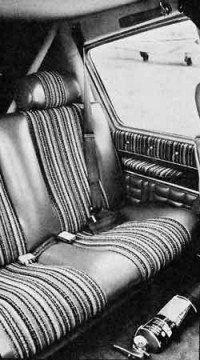
The first
takeoff was memorable only because nothing
happened. The airplane was in the worst
possible situation: warmish temperatures,
gusty wind with hard-edged turbulence, and
we were full up with all seats occupied and
all the gas we could cram into the two
30-gallon wing tanks. As the throttle went
in, the noise built to a pretty respectable
din (even though we had the three-blade
option, which is supposed to be quieter) and
we were pushed further and further back into
our seats as the IAS lunged toward takeoff
speed. With a little coaxing from my check
pilot, Bill Briggs, I lightened the nose at
60 IAS and lifted off at 80 mph. The second
we were off the ground the airplane let it
be known that it wanted to climb. There was
no hesitation, no riding on ground effect.
Just a healthy leap off the runway into a
stable climb.
As I jerked the gear up, Briggs leaned over
and shouted (he had to to be heard) in my
ear "Don't bring the power back below 90 mph
or the gear will come out again."
"Oh, fantastic!" I thought. I had one of
those idiot proof gears aboard. Hiding it
under the not-too-clever name of Auto-Axtion,
Bellanca has seen fit to protect us from
ourselves and our insurance companies by
fit-ting the Vikings with an automatic gear
extension system. Theirs makes more sense
than some, but it has its drawbacks. The
gear automatically goes down anytime the IAS
drops be-low 90 mph unless the throttle is
full open or the master is off. So, if you
don't keep your hand to the wall under 90
mph, you'll be greeted by three winking
lights on the panel. Once you've hit 105
mph, it's supposed to retract again.
Cleaned up and accelerated to a climb speed
of 110 mph, we showed a welcomed 1,000 fpm
plus on the VSI, which got us out of some
fairly severe ground turbulence pronto. When
light, the Viking is a real climbing fool.
The second I cranked over into a left turn
to head for Boston, I fell in love with
Bellancas all over again. Their ailerons are
sensuously smooth and the roll rate is quick
and tight. At first there's a slight
tendency to over-control in roll when
fighting turbulence, but that disappears
quickly, leaving you with the feeling that
you're flying a four-place Pitts.
However, as much as I loved the ailerons, I
hated the elevators, and this proved to be
one of the more irritating aspects of the
Viking to almost everybody I introduced it
to. They didn't like the control harmony, or
the lack of it. The combination of light
quick ailerons, relatively heavy elevators
and a moderately ineffective rudder goes a
long way toward ruining the grace of the
airplane. It's like dancing with a
beautifully agile girl who's wearing combat
boots. Although, with that short tail,
lightening the elevators too much might
cause new pilots to porpoise.
In cruise, those firm elevators combined
with the short tail moment make just about
everybody, myself included, work to hold an
accurate altitude. It just didn't want to
sit in one place, especially in rough air.
If you displace the nose suddenly by jabbing
the yoke, it takes nearly four oscillations,
at a minute apiece, to dampen the movement.
Then it sits at a particular speed and
altitude until the next bump and starts
searching all over again. If I were to do a
lot of IFR work in it, I think I'd like to
have the altitude-hold, which is offered as
a Century series autopilot option.
I've got to give Bellanca a lot of credit
for being one of the few totally honest
companies when it comes to performance
figures. We actually found some of their
numbers a bit conservative. At 75 percent of
power, we consistently indicated 180 to 185
mph and were trueing 190 mph and up, while
Bellanca lists only 187 mph in their
advertising.
You really feel like an airline pilot when
you're humming along in a Viking at 11,500
feet on top of a broken deck, squawking
1400, playfully switching the DME mode back
and forth and watching minutes and knots
magically appear in the windows. This is the
domain of the Viking. Running high and fast,
getting the driver from here to there as
quickly as possible.
Since altitude steals manifold pressure
quickly, the turbocharger option, worth an
additional (and incredible) $8,000 and 20 to
40 mph (223 mph at 24,000 feet!) could
really put a head on the high-altitude
experience.
As we neared Boston; where I was to drop
Bill Briggs, Bellanca regional manager, we
lowered the nose and shot down through a
gigantic (and legal) rift in the clouds
showing 2,500 to 3,000 fpm down on the VSI.
The handbook says emergency letdowns can
give as much as 4,500 fpm, if needed. Now,
that's what I call coming down!
As soon as the airport was in sight, Briggs
started talking about pilots who have
trouble landing the airplane because they
play with the throttle too much and don't
adhere to the recommended method of setting
it up on final at 90 mph and 15 inches and
flying it right onto the runway. He was
trying to offer me advice in a subtle
manner. I pretty much ignored him, as I
still felt very awkward in the machine and
was working much harder than I had expected
to.
With the gear out at 140 mph, I started
messing with the power, and, as predicted,
found myself bobbing all over the glide
path. The sink rate, even at pattern
altitude, seemed to build up very fast when
the power was reduced, but at the time I
didn't think much about it. After I left the
throttle alone, the Viking flew the pattern
as if it knew where it was going, and I kept
the power on right into the flare, screwing
the throttle out as I brought the nose up.
It was a near grease job, or as close as I
ever get, and I had no problem keeping the
nose up as long as I wanted.
The nose gear is direct steering, like a
Cherokee, so it stays cocked if you have a
little rudder in it. I held the nose up long
enough to make sure things were square with
the world so the nosewheel wouldn't jerk us
to one side.
With the amenities of borrowing the airplane
completed (I promised Briggs I'd bring his
airplane back), we loaded up for the trip
home. As I was rolling back onto the runway,
I congratulated myself for being such an
ace, transitioning to this hot, new
superbird so smoothly. But my delusions of
aeronautical grandeur were short-lived, as
my next landing poked a lot of holes in my
ego and taught me a lot more about the
Viking.
I work out of a tiny airport in north Jersey
that's got some of the strangest winds
around. Its 2,000 feet of asphalt actually
jut out into lakes at either end, forming
aircraft-carrier type fan-tails four or five
feet higher than the adjacent water. Combine
this with high ridges on either side of the
runway and you have the makings for all
sorts of violent turbulence right off the
end of the runway. It may not sound like
much, but on windy days, it's been known to
humble more than a few hotshots.
As I got the flaps out and turned final, I
thought I had the airplane and the airport
psyched out. With the sink rate of the
Viking, I figured all I'd have to do was
cautiously jockey the power to stay on glide
path and put the mains right on the end of
the runway.
I had expected some downers and was ready to
fight them, but even though I knew what to
expect, things went to hell in a hurry. I
suddenly found myself very busy fighting
turbulence while keeping that damned vernier
release knob depressed. The airplane just
wasn't reacting the way I expected. When a
downdraft would start sucking us toward the
water, I'd hit the power, but it didn't take
effect until we were into the next updraft
and then I had to yank it off. When I saw I
had the runway made, I committed the final
mistake-I pulled the power off. The
airplane's natural sink rate combined with a
slight downdraft, and threw us toward the
runway at a frightening rate. It happened so
quickly that all I could do was yank the
nose up before contact. Thanks to a fat
cushion of ground effect, the touchdown
wasn't hard at all, but we were skating
along like a shuffleboard puck on a freshly
waxed board. To make matters worse, on
rollout I let the cocked nose wheel touch
the runway for a second, which yanked us off
the centreline rather abruptly. Chalk one up
for the airplane.
After thinking about it for a while, I
thought I'd figured out my problems with the
airplane, but I wanted to see if other
pilots had the same hang-ups. Besides, some
of Bellanca's advertising prose says "docile
as a trainer," and "gentle as a lamb," and I
wanted to check that out on a bunch of
different pilots with varying skill levels.
So, the next morning I rounded up a herd of
local tire kickers including a fairly
low-time Mooney owner, a flight instructor,
a Debonair owner and a couple of airline
pilots.
I sat in the right seat and watched all
these pilots go through the same
embarrassing short-field learning process I
did. The problem seemed to center around
controlling the sink rate in turbulence, and
the vernier throttle. Only the airline types
got by without having the airplane fall out
from under them on at least one landing.
In researching the problem, I went upstairs
and played a little with sink rates. At the
prescribed 15 inches, with gear and full
flaps, the Viking comes down at a very
comfortable 700 to 800 fpm, about like a
power-off Cherokee. Screw the power out just
a smidgen, to 12 to 13 inches and the VSI
leaps up to something in the neighbourhood
of 1,200 fpm. Bring it all the way out and
the needle rockets up to 1,800 to 2,000 fpm,
and that's a fantastic sink rate for a
single-engine airplane. All of this was
happening at an indicated airspeed of 90
mph. At slower speeds it's even more
dependent on power.
One of the really surprising aspects of the
Viking's slow-speed characteristics is the
gentle nature of its stall. Power off, it
runs out of elevator and either breaks
slightly or just continues mushing at around
70 mph. But with 15 inches of manifold
pressure, we were down around 55 mph at full
gross before anything started to happen and
then we had the wheel all the way back and
were only sinking about 500 fpm.
Knowing how the power affected the sink
rate, I started cautioning the troops about
not making large power reductions on final,
which helped a lot, but didn't completely
solve the problem. We still couldn't get the
hang of maintaining an exact glide path
through turbulence to land on a prescribed
spot. If we ignored landing on a spot and
held the power to go motoring right down on
to the first quarter of the runway, the
airplane was a pussycat to land, even in the
gusty wind. But, trying to punch holes in
turbulence to put it right on the end of the
concrete still caused all sorts of problems.
Still puzzled, I did a little more
high-altitude research with the sink rates,
this time not how to start them, but how to
stop them on command. It turned out that
while it takes a reduction of only a couple
of inches of manifold pressure to start the
sink rate, it takes a pretty healthy poke
with the go-stick to stop it. In the case of
a 1,500fpm sink, it took nearly 20 inches to
stop it immediately. This is exactly how
most super-high performance birds fly, even
jets. Once you get a sink rate or
deceleration rate started, it takes the
"lucky three"-time, power, altitude-to get
it stopped.
Something that would make the entire Viking
landing process a lot less troublesome would
be a different type of flap switch setup. As
now designed, you can only select two flap
positions, 23 degrees and a whopping 45
degrees, nothing in between. The pilot has
to be able to pick other flap settings,
preferably with a continuous action switch,
so the switch could be pushed down to a
certain point and the flaps would stop at
the deflection indicated. That way, you
could set up a power setting and partially
control the glide path by dropping flaps a
little at a time. Right now, when you go for
the last notch, you've got a pretty healthy
pitch and speed change to watch for. That's
one reason the recommended procedure is to
get all the flaps out at least halfway down
final.
Also, I wish they'd relocate the flap switch
because I got tired of guys fondling my left
knee as they reached under the passenger's
wheel for the flaps. And the gear lights
should be moved up to the top of the panel
so they'd be easier to cross-check just
before touchdown. Now they are at the
extreme bottom of the panel, partially
hidden by the yoke.
I should probably make the point that in
nine out of 10 situations the Viking is only
marginally more demanding than most
airplanes of the species. Okay, so it's no
Piper Cub and it asks that you fly it
strictly by the numbers, but it's this
subliminal challenge to improve your
piloting technique that makes the airplane
so attractive to so many. Ferraris,
Aston-Martins and the like are far from
being easy cars to drive well. The Viking
falls into the same macho-machine category.
Once you've learned to handle its few
idiosyncrasies, the performance and the gut
feeling of personal accomplishment you're
rewarded with is well worth the effort.
Incidentally, when the turbulence died down
a little, we found we had no problem at all
in getting down and stopped in 1,000 feet.
Bellanca has a brand-new management and
engineering team that has taken dead aim at
the Viking's problems. Because of that, I
predict the next two years will see the
Viking cruising well over 200 mph with the
same engine, and its overall efficiency and
handling characteristics will be fine-tuned
to make the airplane easier for more people
to live with. This is important if they hope
to persuade Skylane and Arrow drivers to
transition into their airplane. As it is
now, a low-time Skylane pilot would age 10
years during his first Viking approach into
a short field on a rough day.
At a sticker price of $34,000, the Viking
really has very little direct competition.
It's most often compared to the Bonanza,
which isn't really fair since the Bonanza
costs a frightening $47,000. The Rockwell
Commander 112 starts at a tad under $30,000
as does the new production Mooney 21. For
$39,000 you get a lot more room and load
capacity in a Cessna Centurion, but it would
take a Centurion II at $44,000 to come even
close to the Viking's interior appointments.
One other problem in buying a Viking is
finding your local Viking dealer so you can
get a ride. The location of Viking dealers
is the best-kept secret in aviation. If you
want to try a Viking on for size, call the
factory in Alexandria, Minnesota, and have
them point you in the right direction.
I wish Bellanca had the money to match their
enthusiasm. I think they've got the right
combination of people and mental attitude to
build an all-new airplane based on the
Viking's concept of performance, handling
and interior, but using modern materials and
techniques. It would be a world beater.
Unfortunately, FAA certification being what
it is, both expensive and lengthy, we'll
probably see the same Bellanca airframe STCd
beyond recognition and produced for another
37 years. Oh well, worse things have
happened. But somehow, I just can't see a
spruce-and-tube airplane with a fanjet-or
can I?
